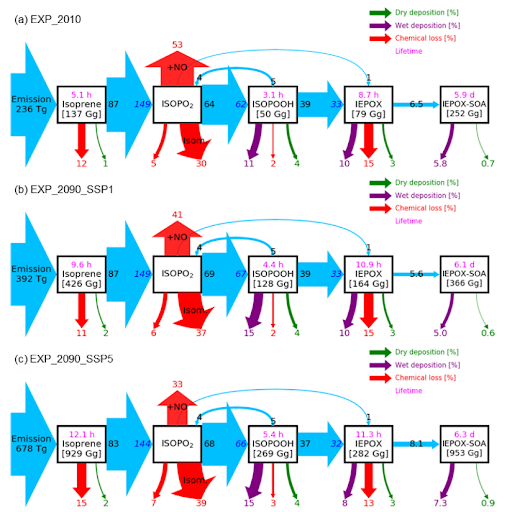Investigating future changes in IEPOX-SOA under SSP scenarios with the explicit chemical mechanism
Secondary organic aerosol (SOA) contributes substantial mass fractions of submicron particle concentrations globally, but it is difficult to predict due to its complex sources and behavior in the atmosphere. There are typically thousands of organic species and reactions involved depending on the precursor hydrocarbon, which necessitates parameterizations in chemistry-climate SOA simulations. However, parameterizations inevitably omit some important processes; for example, the two-product or volatility basis set (VBS) approaches conventionally used in chemical transport models do not consider acid-catalyzed multiphase chemistry and autoxidation. The missing processes can be negligible in simulating present conditions but can become important under future climates with different emissions and meteorological conditions.
The SOA scheme in CAM-chem (CESM2.1.0) has been updated to include explicit chemistry of isoprene-epoxydiol-derived SOA (IEPOX-SOA) to predict IEPOX-SOA under future climatic conditions. An effort led by ACOM scientists investigated future IEPOX-SOA changes under four Tier 1 Shared Socioeconomic Pathways (SSP1-2.6, SSP2-4.5, SSP3-7.0, and SSP5-8.5) using the explicit chemical mechanism and the VBS parameterization. As shown in Figure 1, predicted future conditions are significantly different from present conditions in terms of IEPOX-SOA formation (e.g., isoprene emission, lifetimes of gas-phase precursors, reactive update of IEPOX on the aerosol surface, and the fate of the isoprene peroxy radical).
These dependencies are not explicitly considered in parameterizations, including the VBS approach. As a result, the explicit chemistry simulated 50% differences across different SSP scenarios, but the VBS scheme simulated nearly constant values in terms of the ratio of global SOA burden to isoprene emissions. It would be recommended for climate models to use more comprehensive chemistry, or parameterizations with the correct physicochemical dependencies, to better simulate the sensitivity of SOA in future climatic conditions, which often dominates submicron particulate matter mass.

References
Jo, D. S., Hodzic, A., Emmons, L. K., Tilmes, S., Schwantes, R. H., Mills, M. J., Campuzano-Jost, P., Hu, W., Zaveri, R. A., Easter, R. C., Singh, B., Lu, Z., Schulz, C., Schneider, J., Shilling, J. E., Wisthaler, A. and Jimenez, J. L.: Future changes in isoprene-epoxydiol-derived secondary organic aerosol (IEPOX SOA) under the Shared Socioeconomic Pathways: the importance of physicochemical dependency, Atmos. Chem. Phys., 21(5), 3395–3425, 2021.